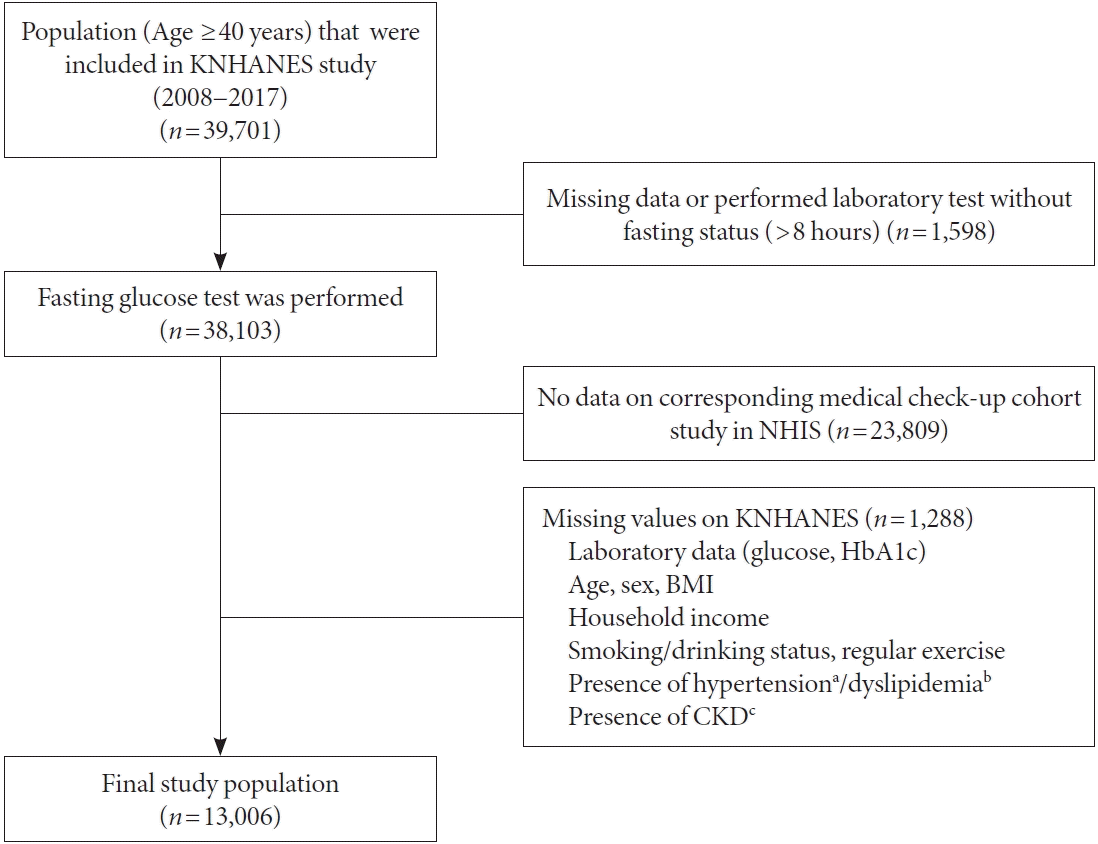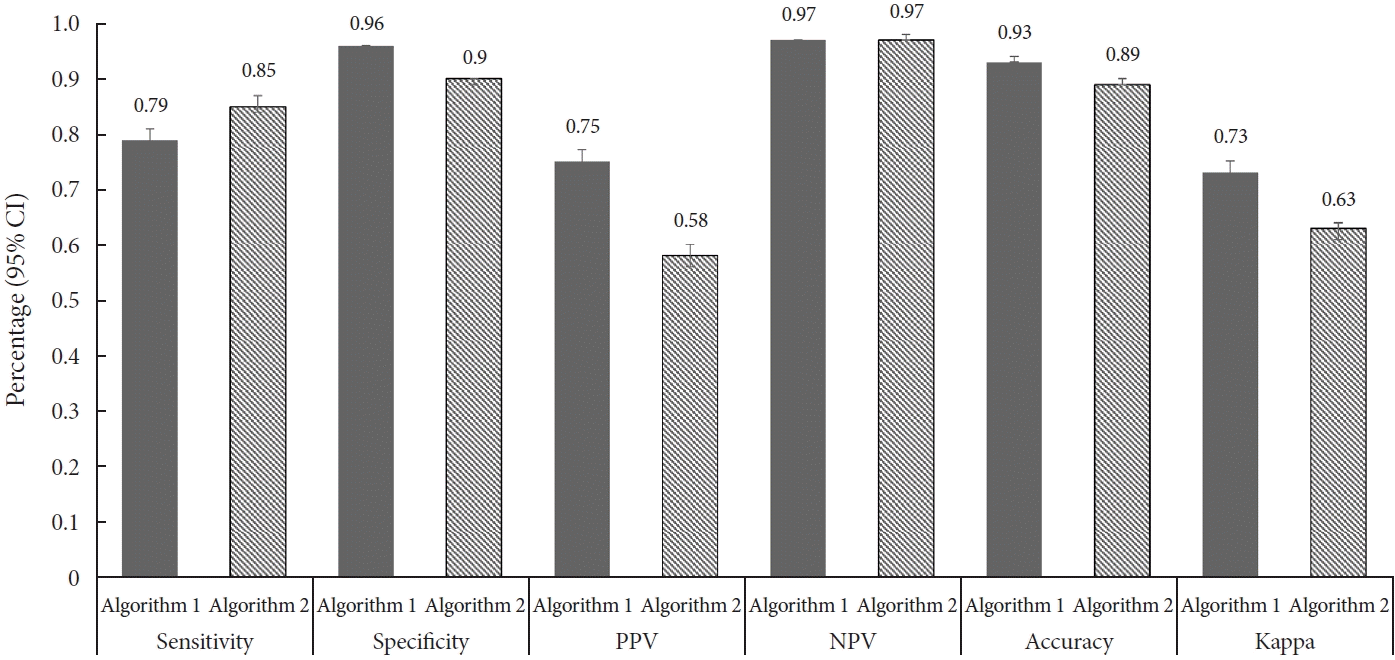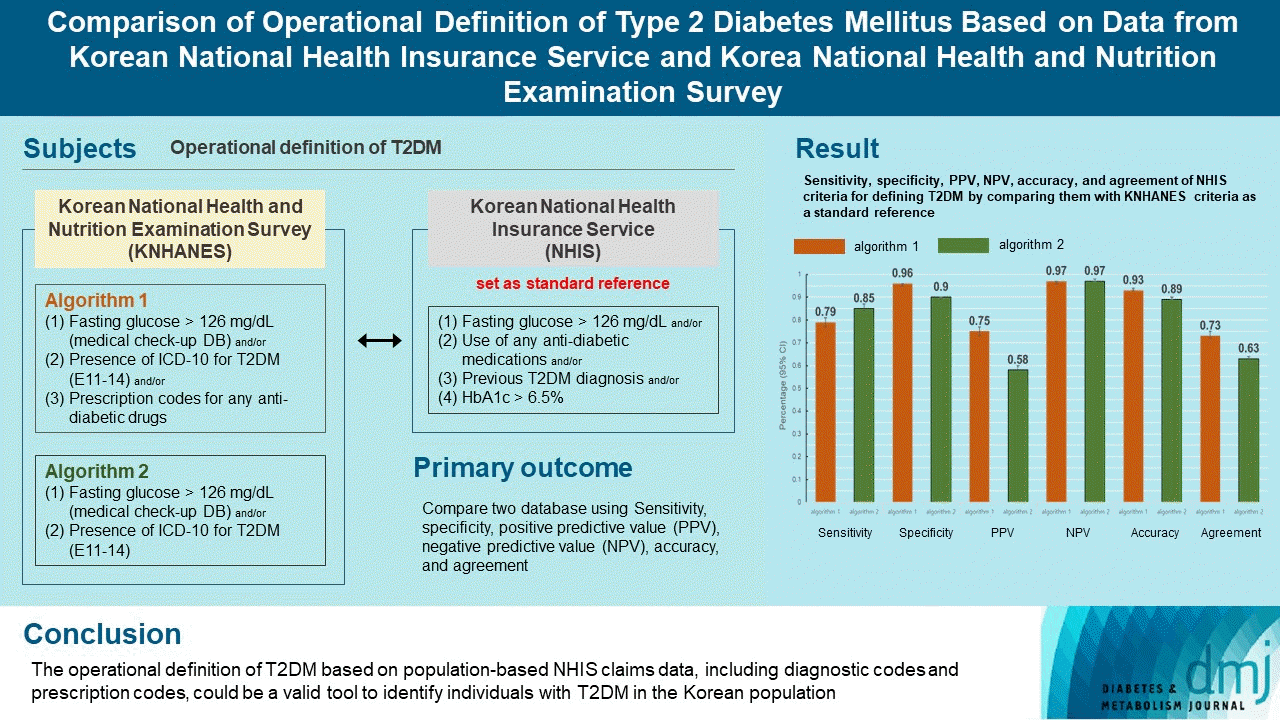1. Cascini S, Agabiti N, Davoli M, Uccioli L, Meloni M, Giurato L, et al. Survival and factors predicting mortality after major and minor lower-extremity amputations among patients with diabetes: a population-based study using health information systems. BMJ Open Diabetes Res Care. 2020; 8:e001355.
2. Choi Y, Choi JW. Association of sleep disturbance with risk of cardiovascular disease and all-cause mortality in patients with new-onset type 2 diabetes: data from the Korean NHISHEALS. Cardiovasc Diabetol. 2020; 19:61.
3. Jung I, Kwon H, Park SE, Han KD, Park YG, Kim YH, et al. Increased risk of cardiovascular disease and mortality in patients with diabetes and coexisting depression: a nationwide population-based cohort study. Diabetes Metab J. 2021; 45:379–89.
4. Kim MK, Han K, Lee SH. Current trends of big data research using the Korean National Health Information Database. Diabetes Metab J. 2022; 46:552–63.
5. Ko SH, Han K, Lee YH, Noh J, Park CY, Kim DJ, et al. Past and current status of adult type 2 diabetes mellitus management in Korea: a National Health Insurance Service Database Analysis. Diabetes Metab J. 2018; 42:93–100.
6. Jagannathan R, Neves JS, Dorcely B, Chung ST, Tamura K, Rhee M, et al. The oral glucose tolerance test: 100 years later. Diabetes Metab Syndr Obes. 2020; 13:3787–805.
7. Lee YH, Han K, Ko SH, Ko KS, Lee KU; Taskforce Team of Diabetes Fact Sheet of the Korean Diabetes Association. Data analytic process of a nationwide population-based study using National Health Information Database established by National Health Insurance Service. Diabetes Metab J. 2016; 40:79–82.
8. Jo SH, Nam H, Lee J, Park S, Lee J, Kyoung DS. Fenofibrate use is associated with lower mortality and fewer cardiovascular events in patients with diabetes: results of 10,114 patients from the Korean National Health Insurance Service Cohort. Diabetes Care. 2021; 44:1868–76.
9. Jeong JS, Kim JS, Yeom SW, Lee MG, You YS, Lee YC. Prevalence and comorbidities of bronchiolitis in adults: a population-based study in South Korea. Medicine (Baltimore). 2022; 101:e29551.
10. Kim J, Yang PS, Park BE, Kang TS, Lim SH, Cho S, et al. Association of proteinuria and incident atrial fibrillation in patients with diabetes mellitus: a population-based senior cohort study. Sci Rep. 2021; 11:17013.
11. Hong JS, Kang HC. Body mass index and all-cause mortality in patients with newly diagnosed type 2 diabetes mellitus in South Korea: a retrospective cohort study. BMJ Open. 2022; 12:e048784.
12. Kim JE, Choi J, Park J, Shin A, Choi NK, Choi JY. Effects of menopausal hormone therapy on cardiovascular diseases and type 2 diabetes in middle-aged postmenopausal women: analysis of the Korea National Health Insurance Service Database. Menopause. 2021; 28:1225–32.
13. Lee CJ, Hwang J, Lee YH, Oh J, Lee SH, Kang SM, et al. Blood pressure level associated with lowest cardiovascular event in hypertensive diabetic patients. J Hypertens. 2018; 36:2434–43.
14. Lee SE, Kim KA, Son KJ, Song SO, Park KH, Park SH, et al. Trends and risk factors in severe hypoglycemia among individuals with type 2 diabetes in Korea. Diabetes Res Clin Pract. 2021; 178:108946.
15. Bae JH, Han KD, Ko SH, Yang YS, Choi JH, Choi KM, et al. Diabetes fact sheet in Korea 2021. Diabetes Metab J. 2022; 46:417–26.
16. Kim J, Bae YJ, Lee JW, Kim YS, Kim Y, You HS, et al. Metformin use in cancer survivors with diabetes reduces all-cause mortality, based on the Korean National Health Insurance Service between 2002 and 2015. Medicine (Baltimore). 2021; 100:e25045.
17. Park JH, Ha KH, Kim BY, Lee JH, Kim DJ. Trends in cardiovascular complications and mortality among patients with diabetes in South Korea. Diabetes Metab J. 2021; 45:120–4.
18. Khokhar B, Jette N, Metcalfe A, Cunningham CT, Quan H, Kaplan GG, et al. Systematic review of validated case definitions for diabetes in ICD-9-coded and ICD-10-coded data in adult populations. BMJ Open. 2016; 6:e009952.
19. Kweon S, Kim Y, Jang MJ, Kim Y, Kim K, Choi S, et al. Data resource profile: the Korea National Health and Nutrition Examination Survey (KNHANES). Int J Epidemiol. 2014; 43:69–77.
20. Lee HY, Shin J, Kim GH, Park S, Ihm SH, Kim HC, et al. 2018 Korean Society of Hypertension guidelines for the management of hypertension: part II-diagnosis and treatment of hypertension. Clin Hypertens. 2019; 25:20.
21. Rhee EJ, Kim HC, Kim JH, Lee EY, Kim BJ, Kim EM, et al. 2018 Guidelines for the management of dyslipidemia. Korean J Intern Med. 2019; 34:723–71.
22. Levin A, Stevens PE. Summary of KDIGO 2012 CKD guideline: behind the scenes, need for guidance, and a framework for moving forward. Kidney Int. 2014; 85:49–61.
23. Dufour MC. What is moderate drinking?: defining “drinks” and drinking levels. Alcohol Res Health. 1999; 23:5–14.
24. Rosenberg DE, Bull FC, Marshall AL, Sallis JF, Bauman AE. Assessment of sedentary behavior with the International Physical Activity Questionnaire. J Phys Act Health. 2008; 5 Suppl 1:S30–44.
25. Simundic AM. Measures of diagnostic accuracy: basic definitions. EJIFCC. 2009; 19:203–11.
26. Landis JR, Koch GG. The measurement of observer agreement for categorical data. Biometrics. 1977; 33:159–74.
27. Chiu CJ, Huang HM, Lu TH, Wang YW. National health data linkage and the agreement between self-reports and medical records for middle-aged and older adults in Taiwan. BMC Health Serv Res. 2018; 18:917.
28. Nishioka Y, Takeshita S, Kubo S, Myojin T, Noda T, Okada S, et al. Appropriate definition of diabetes using an administrative database: a cross-sectional cohort validation study. J Diabetes Investig. 2022; 13:249–55.
29. Lipscombe LL, Hwee J, Webster L, Shah BR, Booth GL, Tu K. Identifying diabetes cases from administrative data: a population-based validation study. BMC Health Serv Res. 2018; 18:316.






 PDF
PDF Citation
Citation Print
Print




 XML Download
XML Download